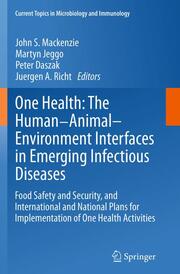Detailansicht
One Health: The Human-Animal-Environment Interfaces in Emerging Infectious Diseases
Food Safety and Security, and International and National Plans for Implementation of One Health Activities, Current Topics in Microbiology and Immunology 366
ISBN/EAN: 9783662523544
Umbreit-Nr.: 9701127
Sprache:
Englisch
Umfang: xvii, 235 S., 7 s/w Illustr., 16 farbige Illustr.,
Format in cm:
Einband:
kartoniertes Buch
Erschienen am 23.08.2016
Auflage: 1/2013
- Zusatztext
- One Health is an emerging concept that aims to bring together human, animal, and environmental health. Achieving harmonized approaches for disease detection and prevention is difficult because traditional boundaries of medical and veterinary practice must be crossed. In the 19th and early 20th centuries this was not the case-then researchers like Louis Pasteur and Robert Koch and physicians like William Osler and Rudolph Virchow crossed the boundaries between animal and human health. More recently Calvin Schwabe revised the concept of One Medicine. This was critical for the advancement of the field of epidemiology, especially as applied to zoonotic diseases. The future of One Health is at a crossroads with a need to more clearly define its boundaries and demonstrate its benefits. Interestingly the greatest acceptance of One Health is seen in the developing world where it is having significant impacts on control of infectious diseases.
- Kurztext
- The second volume on One Health explains in detail how to implement three key aspects of the One Health paradigm-food safety and security, national plans for a holistic one health approach, and relevant new technologies and approaches. The fourteen chapters, each by an internationally recognized authority, are organized into three sections of four or five chapters each, that break new ground in clarifying precisely how One Health can become an operational reality in local, national and international public health initiatives. Section three begins with an international overview on food safety and security. The importance of a One Heath approach is then explained in relation to four specific problems-the growing prevalence of antibiotic resistance, bovine spongiform encephalopathy and pathogenic E.coli.Section four begins with the role of the Food and Agricultural Organization (FAO) in promoting One Health. The formulation and implementation of national plans for implementing the One Health paradigm are then set out for Africa, the Western Pacific, Southeast Asia and Mongolia. The final section of this two volume book is devoted to implementing new technologies and new approaches to One Health. A wide-ranging analysis considers the importance of climate change and a social-ecological systems approach, as well as how to operationalize One Health, how to move from emergency response to prevention at source, and how to implement an educational strategy that builds a foundation for One Health in emerging disease management. It is anticipated that this two volume book will become a benchmark for practitioners of One Health, empowering a balanced multidisciplinary approach to the complexities of the human-animal-environment interface.
- Autorenportrait
- John S. Mackenzie was one of the volume editors of "Wildlife and Emerging Zoonotic Diseases: the Biology, Circumstances and Consequences of Cross-species Transmission", CTMI vol. 315, ISBN 978-3-540-70961-9, published in 2007
